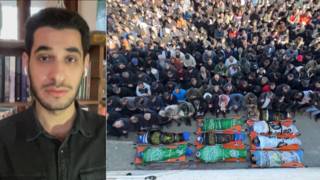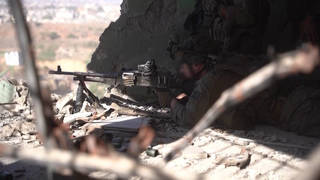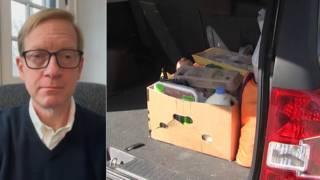
Related
Guests
- Jihan Hafizindependent journalist currently reporting for Democracy Now! from the Canadian ship Tahrir, which is part of a flotilla heading to the Gaza Strip.
- Jane Hirschmanncoordinator of the U.S. delegation for the Freedom Waves to Gaza flotilla.
- Col. Ann Wright (Ret.)retired U.S. Army colonel and former U.S. diplomat who spent 29 years in the military and later served as a high-ranking diplomat in the State Department. She was a passenger on The Audacity of Hope U.S.-flagged ship in a recent Gaza aid flotilla. She was also on the first Freedom Flotilla.
Two Gaza-bound boats carrying pro-Palestinian activists are within 50 nautical miles of their destination, but reports are emerging that Israeli Navy ships have intercepted the “Freedom Waves to Gaza” flotilla. Communication with the boats has largely been cut off. Prior to losing contact, we received two exclusive video reports from aboard the “Tahrir,” the Canadian ship. Speaking to Democracy Now! correspondent Jihan Hafiz last night, passenger Ehab Lotayef said, “We are approaching the 100-nautical-mile point away from Gaza, which is usually the point where Israel declares—starts the blockade … Will they try to come and board us? All these questions are now at the moment of truth. The major preparation we did is to prepare that we don’t want anybody to act in any violent way or in any way that can even induce violence by the Israelis.” [includes rush transcript]
Transcript
AMY GOODMAN: We’re on the road in Syracuse, New York. As we go to broadcast, we’re receiving reports that the Freedom Waves flotilla to Gaza is being approached by Israeli naval vessels. Sandra Ruch, part of the steering committee for the Canadian boat, called in this report just as we went to air.
SANDRA RUCH: …in Istanbul, Turkey, and I’ve been in constant contact with the Tahrir. He have just lost communication. The last thing we heard was from Fintan Lane of the Irish boat that they could see the Israeli army or navy offshore, and they are at 51 nautical miles from Gaza. So we have now lost communication completely with our boats.
AMY GOODMAN: As we broadcast now, a Canadian and Irish boat are en route to Gaza, about 48 nautical miles from their destination. The Freedom Waves to Gaza flotilla marks the latest attempt by international activists to break the Israeli naval blockade of Gaza. Earlier this year, Greece blocked the departure of several ships from another flotilla heading to the region. In 2010, Israeli forces killed nine Turkish activists, including a U.S. citizen, on an aid boat called the Mavi Marmara, which was part of the first such international flotilla. The Canadian boat is called Tahrir, Arabic for “liberation.”
Democracy Now! correspondent Jihan Hafiz is on board the Tahrir. She filed this report.
JIHAN HAFIZ: It’s the second day of the Freedom Waves to Gaza flotilla, and the Tahrir moved closer to its destination on Thursday. However, organizers remain on high alert. The Israeli Defense Forces threatened to block the boats from breaching the Gaza blockade by sea. Delegates and journalists met to discuss the Israeli navy intercepting the boats and the possibility of violent confrontation. After weeks of secretly planning the flotilla, activists with the Canadian boat finally made physical contact with their Irish counterparts. Although the boats did not exchange passengers due to rough waters, their proximity boosted the spirits of those on both vessels.
KAREN DEVITO: Free Gaza! Free Palestine!
JIHAN HAFIZ: Activists understand their strength is not in numbers, but rather in the powerfully symbolic act of attempting to break the siege despite the risk of another violent attack by the Israeli navy.
MICHAEL COLEMAN: Michael Coleman from Sydney, Australia. I’m representing the Free Gaza Australia on the first Freedom Waves flotilla to Gaza. My family and friends are very supportive, and I haven’t had to sort of choose between too many things. It is a financial strain on me, as I’m only a youth worker, and, you know, social services don’t get paid that well, but it’s money well spent, in my opinion.
JIHAN HAFIZ: Michael attempted to reach Gaza in the summer but never made it, when the Greek government prevented the Tahrir from leaving the country. This time he serves as a member of the crew and expresses his satisfaction about his efforts to end Israel’s four-year blockade of the Gaza Strip.
MICHAEL COLEMAN: Well, I tried to tone down my expectations on this trip, because last time, when we tried to sail out of Crete in June and July, we hit a wall of bureaucratic obstacles, which I didn’t anticipate, and I came back with a definite sense of frustration. So, I came not to have too many high hopes for this trip. But it’s with great joy I tell you I’m now sitting in international waters, and we got out of the bureaucracy in Turkey. And now Gaza awaits us. Yes, there is a level of nerves about being confronted by what I like to term the IOF, the Israeli Occupation Forces. They have a long history of targeting peaceful protesters with violence, which is totally unacceptable, but that’s meant as a deterrent to us.
EHAB LOTAYEF: Ehab Lotayef, one of the organizers of the Canadian boat to Gaza and a delegate on board towards Gaza. It’s now 7:30 Friday morning. We are approaching the hundred-nautical-mile point away from Gaza, which is usually the point where Israel declares—starts the blockade. So, at this point we are getting anxious, in a way, to know when will they put a blackout on our communications, if they will put it. When will they try to come and board us? Will they try to come and board us? All these questions are now at the moment of truth. The major preparation we did is to prepare that we don’t want anybody to act in any violent way or in any way that can even induce violence by the Israelis. All the spirits are good. Everybody is cooperating. We feel that we really have a very successful mission up to now. Everybody is happy with what’s happening. And we are still hopeful to get to Gaza, actually.
JIHAN HAFIZ: Majd Kayal, a 20-year-old university student, is the only Palestinian on board.
What is life like for you in Israel?
MAJD KAYAL: The question of who I am was always—not only for me, for all the Palestinians that grow in Israel, this—the question of identity, of who I am. I am Palestinian, but I am not. But I have a blue ID, which is the Israeli ID. Being Palestinian is not something that you choose. I didn’t choose to be part of the struggle. It’s not—I didn’t make this choice. I was born with it. I was born with the fact that I am suffering from the [inaudible] state, that I am not a citizen in this state, or citizen in a low—in a lower place than the Jewish citizen in Israel.
JIHAN HAFIZ: How do you feel about being the only Palestinian on this trip?
MAJD KAYAL: I feel sorry. I think that it has to be more Palestinians on the boats and in all the boats. I think it has to be Palestinian boats from different places in Europe. I hope it will be soon, not only for Gaza. I really think that we have idea of the return boats, boats of refugees that try to get to Jaffa or to Haifa or to Akka, to the cities that their parents were born. And I believe that only the Palestinian people can liberate itself. We need the support, and we need the world, the whole world, to stand with us, but I believe that only the Palestinian people can fight for its rights. Only the Palestinian people can really liberate itself and liberate Palestine from the colonization.
JIHAN HAFIZ: As the sun set over the Mediterranean, memories of the Mavi Marmara attack reminded passengers of the Tahrir that Israel could strike at any moment. The most violent attack against the peace convoy to Gaza came 95 kilometers off the coast of Gaza, when Isreali commandos entered international waters, stormed the flotilla, killing nine Turkish activists and wounding many others. Activists and journalists began to prepare themselves for a possible surprise attack in the later hours of the morning, as the Tahrir and the Saoirse approached Gaza. They expect to come within a hundred kilometers from the coast sometime during the evening. Jihan Hafiz for Democracy Now! on the Tahrir en route to Gaza.
AMY GOODMAN: Just as we went to broadcast this morning, we lost touch with Jihan, Democracy Now!’s Jihan Hafiz, on the boat, on the Canadian boat Tahrir, as they were moving closer to Gaza. But at this point, we have word that Israeli naval ships have surrounded both the Canadian and the Irish boat in the flotilla. But before we lost contact, Jihan filed this update.
JIHAN HAFIZ: We’re about 82 nautical miles from the coast of Gaza, and the Israeli navy has not been spotted. Activists and organizers on the ships say we’re lucky to have made it this far without an interception by the Israelis. There have been a number of preparations underway here on the boats to prepare for the Israeli navy, if they come. The captain reduced the speed of the boat last night to ensure that both vessels would arrive or would come close to the 100-nautical-mile mark at daylight. If the voyage goes smoothly and the Israelis do not intercept both vessels, then this one and the Irish one would arrive in Gaza nine hours from now at about 2:00 to 3:00 Gaza’s time. Everyone on the boat is excited to have made it this far without the Israelis intercepting the boats. There have been preparations underway all night, as well as into this morning, in the event that the Israelis do board the ships. Despite that, however, spirits remain high, and many optimistic that they will reach Gaza, if the Israelis—
AMY GOODMAN: You’ve just heard Jihan Hafiz. She was just reporting to us from the Tahrir. Now, again, we have just lost contact with the boats, so we’re bringing on Jane Hirschmann. She’s in the United States. She’s one of the coordinators of the flotilla, the international support committee.
Jane Hirschmann, if you can tell us what you understand is happening at this point.
JANE HIRSCHMANN: There are two Israeli warships that have surrounded the—our boats, and they are in contact by radio. And Canadian activist Ehab Lotayef, when he was asked, “Where are you going? What is your destination?” he replied, “The conscience of humanity.” And when they repeated that question, asking for his final destination of the two boats, he said, “The betterment of mankind.” So, at this point, we have lost contact with the ships, but we know that they are currently surrounded, and they are being contacted via radio. The ships are talking to the Israelis.
AMY GOODMAN: So, you have had contact with the two boats here, the Irish ship and the Tahrir, which is the Canadian ship, where Jihan Hafiz, our reporter, was just broadcasting from.
JANE HIRSCHMANN: That’s correct. But now we have all lost communication with them. They have lost [inaudible] —
AMY GOODMAN: Earlier, hours ago—actually, when we were flying into Syracuse, New York, we got word that ships and planes—this was many hours ago—had actually—were doing some kind of reconnaissance, and then they left. Is this what you heard, as well? It was last night.
JANE HIRSCHMANN: Actually, there was a ship following them for hours. And that is pretty typical in these flotillas, that ships can follow you for a very long time. Then they lost sight of the ship, and they did see an aircraft above. Then they lost sight of the aircraft. And then, in early morning hours, they saw one of the ships again. So it’s just a—
AMY GOODMAN: And Jane Hirschmann, you were on The Audacity of Hope. You were on one of the boats in the flotilla that attempted to leave Greece a few months ago, that was a U.S.-flagged ship. The significance of this secret two-boat flotilla that did make it out of a Turkish port? And, well, we’ll see what happens right now.
JANE HIRSCHMANN: Right. I wasn’t on the boat; I was the—one of the organizers of the boat. But it’s very important that this time we kept it secret. Very, very few people knew. And we had to keep it secret, because this is a civil society action, it is not a governmental one. And we wanted no interference from any governments, because we wanted to do this, and the only way was to keep it very, very secret.
AMY GOODMAN: Jane Hirschmann, I want to thank you for being with us.
We’re here in Syracuse, New York, and I want to bring in Colonel Ann Wright. She is a former diplomat. She quit over the war in Afghanistan. She is here in Syracuse, because she joined with 37 other people in protesting drone strikes, drones that are run from a base here in Syracuse, and we’re going to talk about that in the next segment.
But, Colonel Ann Wright, you were on The Audacity of Hope. In fact, you were on the first international flotilla that was challenging the Israeli naval blockade of Gaza. You were on the boat next to the Mavi Marmara, where nine Turkish citizens were killed by the Israeli military. One of those activists who were killed was actually a U.S. citizen, born not far from where we are now, in Syracuse, New York. Can you talk about the significance of, at this point, what we know is two boats—we lost touch with the Canadian boat about 48 nautical miles from Gaza, but now being surrounded by Israeli navy, but making their way, attempting, to Gaza?
ANN WRIGHT: Well, I can imagine what’s going on on those boats, as the Israeli commandos boarded us in 2010. They storm on board. There’s lots of noise. There’s lots of yelling. There’s weapons being pointed at people. “Get down! Get down! Don’t talk! Don’t do anything!” It’s a very scary time, quite honestly. But what—it’s scary, but it’s this thing that these people want to be doing. There are 27 people among the two boats. They want to be a part of the wave of citizen activists who continue to challenge the Israeli naval blockade of Gaza.
AMY GOODMAN: Describe what happened, as you were next to the Mavi Marmara, the Turkish ship. What was the name of your boat?
ANN WRIGHT: Our boat was the Challenger II.
AMY GOODMAN: How far were you from the Mavi Marmara?
ANN WRIGHT: Initially, we were about a hundred yards off its port stern. And we saw helicopters coming over, starting the assault on the Mavi Marmara. We saw commandos from the boat shooting what we didn’t know at the time was live ammunition up into the stern of the Mavi Marmara. And then, after about two minutes of that, we then took off and tried to outrun the patrol boats.
AMY GOODMAN: And how far were you from Gaza?
ANN WRIGHT: We were about 70 miles from Gaza. We were quite far away, in international waters, as are these two boats, still. Forty-eight miles is still in international waters.
AMY GOODMAN: How many people were on your boat? And why you, a colonel, U.S. military, a former ambassador, deputy ambassador to Mongolia? You quit under President George W. Bush. Why did you go on this boat?
ANN WRIGHT: Well, in my letter of resignation to President Bush, not only did I resign over the Iraq war, but also in my letter I mentioned the unequal policies that we have on Palestine and Israel. And I felt it was important to put my voice and my body where it counted and to be a part of an international group to challenge the Israeli naval blockade of Gaza.
AMY GOODMAN: The Israeli military says they just don’t want weapons being brought into Gaza.
ANN WRIGHT: Well, and these flotillas, these boats on the flotillas, are not bringing in weapons, and they very well know that. The fact that the Israelis continue, after 48 years now of blockading Gaza, of not allowing materials to come in by sea or to go out by sea, is something that international activists are going to continue to pressure the international community, the international community of governments who are supporting the Israelis, and of course the United States government, which is its biggest supporter with $3 billion a year and protection in the United Nations on every vote that concerns Israel and Palestine.
AMY GOODMAN: We’re going to come back to this discussion around people taking direct action. Again, Ann Wright, a retired Army colonel, former U.S. diplomat, who spent 29 years in the military, served as a high-ranking diplomat in the State Department. In 2001, she helped oversee the reopening of the U.S. mission in Afghanistan, then in 2003 resigned her post in protest to the war in Iraq. On two of these flotillas, the first with the Mavi Marmara and then The Audacity of Hope. That was a U.S.-flagged ship.
ANN WRIGHT: That’s correct. The Audacity of Hope was U.S.-flagged, as was the Challenger II.
AMY GOODMAN: The boat that you were on.
ANN WRIGHT: Yes. Both were U.S.-flagged. The United States government has made no investigation itself over the murder, the execution, of the U.S. citizen Furkan Dogan nor the—
AMY GOODMAN: That was the young man who was one of the nine activists on board the Mavi Marmara who was killed by the Israeli military, born because—in the United States, his father was a professor.
ANN WRIGHT: That’s right, born in Troy, New York. He was killed with five bullets to his body, including one to the head to execute him, which we can identify on the Israeli videos that they have now released.
AMY GOODMAN: And we have interviewed his father, and you can go to our website at democracynow.org. We’re going to come back to Ann Wright on another issue, why she is here in Syracuse today, one of the Hancock 38 Drone Resisters. We’ll be back in a moment.












Media Options